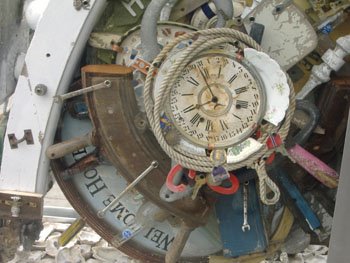 A few nights ago a volunteer group asked me to lead them on a "tour" of the town--it was already pitch black, so the only place I could think to go that was well-lit (besides the casinos, of course) was the local Katrina memorial, where a stark granite wall marks the height of the storm surge, and a collage made from artifacts locals found in the wreckage of their homes sits under floodlights. It's continuously illuminated in a way that reminds me of a war monument or the Tomb of the Unknown Soldier. In a way it's both, I guess--350 some people died in the storm, and almost 20 months after she hit they still haven't identified all the bodies.
A few nights ago a volunteer group asked me to lead them on a "tour" of the town--it was already pitch black, so the only place I could think to go that was well-lit (besides the casinos, of course) was the local Katrina memorial, where a stark granite wall marks the height of the storm surge, and a collage made from artifacts locals found in the wreckage of their homes sits under floodlights. It's continuously illuminated in a way that reminds me of a war monument or the Tomb of the Unknown Soldier. In a way it's both, I guess--350 some people died in the storm, and almost 20 months after she hit they still haven't identified all the bodies.

We walked around the memorial, peering at Little League trophies and battered silverware and rosaries and a silver "Most Likely To Be Missed" plaque from a high school class circa 1970; we then crossed the street over to our van, which was parked in the shadow of a multi-storied apartment complex that looks perfectly normal until you realize that the entire first floor has been erased.

Once back in our vehicle, we drove a few blocks east to an Episcopal church just off the water; like a cow carcass set upon by piranhas, the structure was picked completely clean by the immense wall of water that swept the coast that day. The surrounding property is one big mess of debris and brush, fallen trees and stubborn stumps and prickly, crackly vegetation, and out of it rise the rusted, dully red legs of a giant spidery sculpture, obscenely splayed like a tragicomic parody of the fiery orange Calder Flamingo in downtown Chicago. These metal beams are all that's left of a once graceful sanctuary built in 1969 after Hurricane Camille destroyed the original church building in 1969--talk about bad luck. Its congregation had chosen to rebuild in the same spot that first time because they were inspired, I suppose, by its proximity to water, that holiest of elements. This time, not without heavy hearts, they're relocating north of the interstate, a good 3 or 4 miles away.
It's in those moments--when you find yourself scrambling over the implacable rubble of a church, or when you notice that that piece of plastic ground into the dirt next to you as you cut across someone's lawn is an orphaned hairbrush, barely recognizable; when you feel the sky go grey and the wind pick up and the lightning dance a little jig across the tree tops and you're reminded in no uncertain terms that you now live in Hurricane Country; when you read a heart-wrenching Chris Rose* column about New Orleans struggling to revive itself after the storm and it socks you in the solar plexus because it is so real and because you know that so many houses sit empty, still--that's when you know, in your bones, why you're down here.
PS. A huge THANK YOU to all who participated in last Saturday's nation-wide Stamp Out Hunger US Postal Service food drive! Our food pantry was the recipient of over two mail trucks full of cans and dry goods, and although our caseworker was a little overwhelmed by the sheer volume of food--I don't think any of us had ever seen so many cans of potted meat--we were all thrilled to have so much food to distribute to our clients. Well done postal customers!!
*Chris Rose is a stellar Times-Picayune columnist who returned to the city literally hours after the storm to report on the devastation and whose writings acted as a lifeline for many exiled New Orleanians longing for news of home in Katrina's aftermath. A book of his collected post-Katrina columns, 1 dead in attic, is phenomenal; it is a must-read for anybody who wants to understand (as much as it is possible for someone who didn't live through it) what the city and the people that love her went through. http://www.chrisrosebooks.com/







1 comment:
Thank you for the tour. It's amazing to see things in person. Photos just can't tell the whole story.
Also, I have tagged you. You are "it." Read my 23 May 07 post to see what it's about, and participate if you like.
Post a Comment